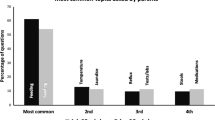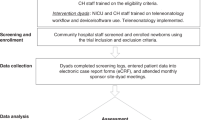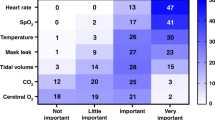Abstract
Objective:
To describe the use of a wireless, mobile, robotic telecommunications system in the Neonatal Intensive Care Unit (NICU).
Study Design:
In this prospective study utilizing 304 patient encounters on 46 preterm and term neonates in a level IIIa NICU, a bedside neonatologist (‘on-site neonatologist’; ONSN) and a neonatologist at a distant location (‘off-site neonatologist’; OFFSN) evaluated selected demographic information, laboratory data and clinical and radiological findings of the subjects. The OFFSN used a commercial wireless, mobile, robotic telecommunications system controlled from a remote site. The two physicians were blinded to each other's findings and agreement rates of the evaluations between the ONSN and the OFFSN were compared using kappa statistics. Agreement rates between two ONSNs using the same protocol with 39 patient encounters served as the reference standard. The dependability and timeliness of data transmission were also assessed.
Result:
Excellent or intermediate-to-good agreements were noted for all but a few physical examination assessments between both the ONSN and OFFSN and the two ONSNs. Poor agreements were found for certain physical examination parameters (breath-, heart- and bowel-sounds and capillary refill time) with or without the use of telemedicine. The median duration of the encounters by the ONSN and OFFSN and the two ONSNs was similar. Five encounters were excluded from the analysis because of technical difficulties. No complications associated with the use of the mobile robot were noted.
Conclusion:
Our findings indicate that the use of mobile robotic telemedicine technology is feasible for neonates in the NICU.
This is a preview of subscription content, access via your institution
Access options
Subscribe to this journal
Receive 12 print issues and online access
$259.00 per year
only $21.58 per issue
Buy this article
- Purchase on Springer Link
- Instant access to full article PDF
Prices may be subject to local taxes which are calculated during checkout

Similar content being viewed by others
References
Jarvis-Selinger S, Chan E, Payne R, Plohman K, Ho K . Clinical telehealth across the disciplines: lessons learned. Telemed J E Health 2008; 14: 720–725.
Marcin JP, Ellis J, Mawis R, Nagrampa E, Nesbitt TS, Dimand RJ . Using telemedicine to provide pediatric subspeciality care to children with special health care needs in an underserved rural community. Pediatrics 2004; 113 (1 part 1): 1–6.
Sable CA, Cummings SD, Pearson GD, Schratz LM, Cross RC, Quivers ES et al. Impact of telemedicine on the practice of pediatric cardiology in community hospitals. Pediatrics 2002; 109 (1): e3.
Rosenfeld BA, Dorman T, Breslow MJ, Pronovost P, Jenckes M, Zhang N et al. Intensive care unit telemedicine: alternate paradigm for providing continuous intensivist care. Crit Care Med 2000; 28: 3925–3931.
Pronovost PJ, Angus DC, Dorman T, Robinson KA, Dremsizov TT, Young TL . Physician staffing patterns and clinical outcomes in critically ill patients: a systematic review. JAMA 2002; 288: 2151–2162.
Burchardi H, Moerer O . Twenty-four hour presence of physicians in the ICU. Critical Care 2001; 5: 131–137.
Health B, Salerno R, Hopkins A, Hertzig J, Caputo M . Pediatric critical care telemedicine in rural underserved emergency departments. Pediatr Crit Care 2009; 10 (5): 588–591.
Wetzel RC . Practice in the new millennium. Pediatr Clin North Am 2001; 48 (3): 795–814.
Kofos D, Pitetti R, Orr R, Thompson A . Telemedicine in pediatric transport: a feasibility study. Pediatrics 1998; 201 (5): 1–3.
Hall RW, Hall-Barrow J, Garcia-Rill E . Neonatal regionalization through telemedicine using a community-based research and education core facility. Ethn Dis 2010; 20 (1 Suppl 1)S1: 136–140.
Jain AR, Agarwal R, Chawla D, Paul V, Deorar A . Tele-education vs classroom training of neonatal resuscitation: a randomized trial. J Perinatol 2010; 30 (12): 773–779.
Gray JE, Safran C, Davis RB, Pompilio-Weitzner G, Stewart JE, Zaccagnini L et al. Baby CareLink: using the internet and telemedicine to improve care for high-risk infants. Pediatrics 2000; 106: 1318–1324.
Jones PK, Jones SL, Halliday HL . Evaluation of television consultations between a large neonatal care hospital and a community hospital. Medical Care 1980; 18: 110–116.
Robie DK, Naulty CM, Parry RL, Motta C, Darling B, Micheals M et al. Early experience using telemedicine for neonatal surgical consultations. J Pediatr Surg 1998; 33: 1172–1176.
Lorenz B, Spasovska K, Elflein H, Schneider N . Wide-field digital imaging based telemedicine for screening for acute retinopathy of prematurity (ROP). Six-year results of a multicentre field study. Graefes Arch Clin Exp Ophthalmol 2009; 247: 1251–1262.
Casey FD, Brown D, Craig BG, Rogers J, Mulholland HC . Diagnosis of neonatal congenital heart defects by remote consultation using a low-cost telemedicine link. J Telemed Telecare 1996; 2: 165–169.
Rendina MC . The effect of telemedicine on neonatal intensive care unit length of stay in very low birthweight infants. Proc AMIA Symp 1998; 111–115.
Rendina MC, Downs SM, Carasco N, Loonsk J, Bose CL . Effect of telemedicine on health outcomes in 87 infants requiring neonatal intensive care. Telemed J 1998; 4: 345–351.
Mulholland HC, Casey FD, Brown D, Corrigan N, Quinn M, McCord B et al. Application of a low cost telemedicine link to the diagnosis of neonatal congenital heart defects by remote consultation. Heart 1999; 82: 217–221.
Sable C, Roca T, Gold J, Gutierrez A, Gulotta E, Culpepper W . Live transmission of neonatal echocardiograms from underserved areas: accuracy, patient care, and cost. Telemed J 1999; 5: 339–347.
Grant B, Morgan GJ, McCrossan BA, Crealey GE, Sands AJ, Craig B et al. Remote diagnosis of congenital heart disease: the impact of telemedicine. Arch Dis Child 2010; 95: 276–280.
Yamamoto LG . Using JPEG image compression to facilitate telemedicine. Am J Emerg Med 1955; 13: 55–57.
Martin JA, Kochanek KD, Strobino DM, Guyer B, MacDorman MF . Summary of vital statistics - 2003. Pediatrics 2005; 115: 619–634.
Fanaroff AA, Stoll BJ, Wright LL, Carlo WA, Ehrenkranz RA, Stark AR et al. Trends in neonatal morbidity and mortality for very low birthweight infants. Am J Obstet Gynecol 2007; 196: 147. e1–8.
Stephens BE, Vohr BR . Neurodevelopmental outcome of the premature infant. Pediatr Clin North Am 2009; 56: 631–646.
Konduri GG, Kim UO . Advances in the diagnosis and management of persistent pulmonary hypertension of the newborn. Pediatr Clin North Am 2009; 56: 579–600.
RP-7 Remote Presence System–Manual. InTouch Technologies, Inc.: Santa Barbara, CA.
Jarvisa L, Stanberry B . Teleradiology: threat or opportunity? Clin Radiol 2005; 60: 840–884.
Boriani G, Diemberger I, Martignani C, Biffi M, Valzania C, Bertini M et al. Telecardiology and remote monitoring of implanted electrical devices: the potential for fresh clinical care perspectives. J Gen Intern Med 2008; 23 (Suppl 1): 73–77.
Hailey D, Ohinmaa A, Roine R . Published evidence on the success of telecardiology: a mixed record. J Telemed Telecare 2004; 10 (Suppl 1): 36–38.
Zimmer-Galler IE, Zeimer R . Telemedicine in diabetic retinopathy screening. Int Ophthalmol Clin 2009; 49: 75–86.
Breslow MJ . Remote ICU care programs: current status. J Crit Care 2007; 22: 66–76.
Whitten P, Mair F . Telesurgery versus telemedicine in surgery - an overview. Surg Technol Int 2004; 12: 68–72.
Varkarakis IM, Rais-Bahrami S, Kavoussi LR, Stoianovici D . Robotic surgery and telesurgery in urology. Urology 2005; 65: 840–846.
Acknowledgements
This work was supported by the UniHealth Foundation Grant (#951) and ‘The Laura P and Leland K Whittier Virtual PICU’ Junior Faculty Fellowship for Research in Telemedicine Award (SP). The authors thank Pam Costa, the data collection coordinator and Paul Vee, the technical coordinator of the study for their dedicated work. The authors also thank Drs James Gray and Randall C Wetzel for their help with the preparation of the paper. Finally, the authors would also like to acknowledge the support provided by the administration and information technology departments of Children's Hospital Los Angeles and Hollywood Presbyterian Medical Center and are indebted to the beside nurses and respiratory therapists in the NICU at Hollywood Presbyterian Medical Center for their dedicated work and contribution.
Author information
Authors and Affiliations
Corresponding author
Ethics declarations
Competing interests
The authors declare no conflict of interest.
Additional information
Preliminary findings of this study were presented at the PAS/SPR Annual Meeting in Baltimore, MD, USA in 2009.
Rights and permissions
About this article
Cite this article
Garingo, A., Friedlich, P., Tesoriero, L. et al. The use of mobile robotic telemedicine technology in the neonatal intensive care unit. J Perinatol 32, 55–63 (2012). https://doi.org/10.1038/jp.2011.72
Received:
Revised:
Accepted:
Published:
Issue Date:
DOI: https://doi.org/10.1038/jp.2011.72
Keywords
This article is cited by
-
Virtual family-centered hospital rounds in the neonatal intensive care unit: protocol for a cluster randomized controlled trial
Trials (2023)
-
A review on the significance of body temperature interpretation for early infectious disease diagnosis
Artificial Intelligence Review (2023)
-
Utility of telemedicine in pediatric rheumatology during the COVID-19 pandemic
Pediatric Rheumatology (2021)
-
Decreasing patient cost and travel time through pediatric rheumatology telemedicine visits
Pediatric Rheumatology (2016)
-
A zero power harmonic transponder sensor for ubiquitous wireless μL liquid-volume monitoring
Scientific Reports (2016)



